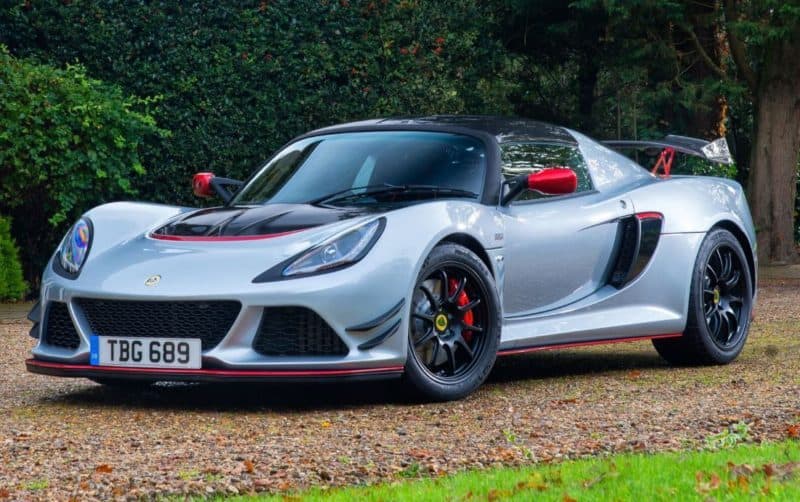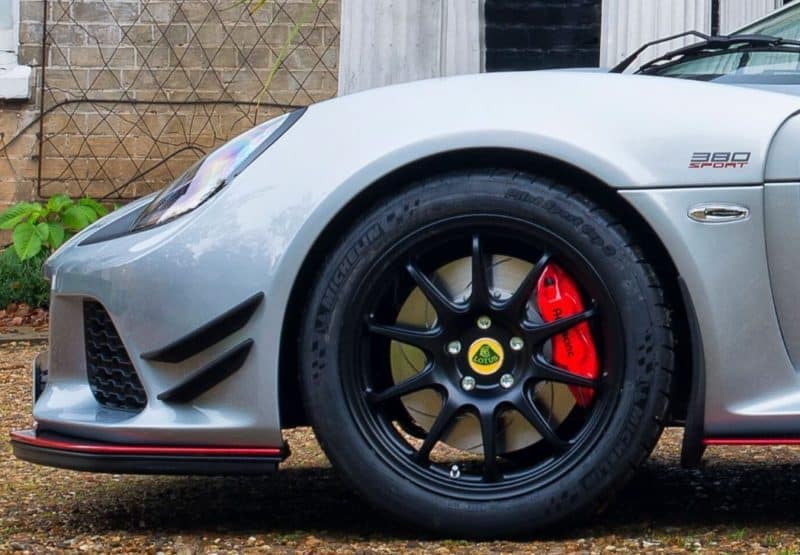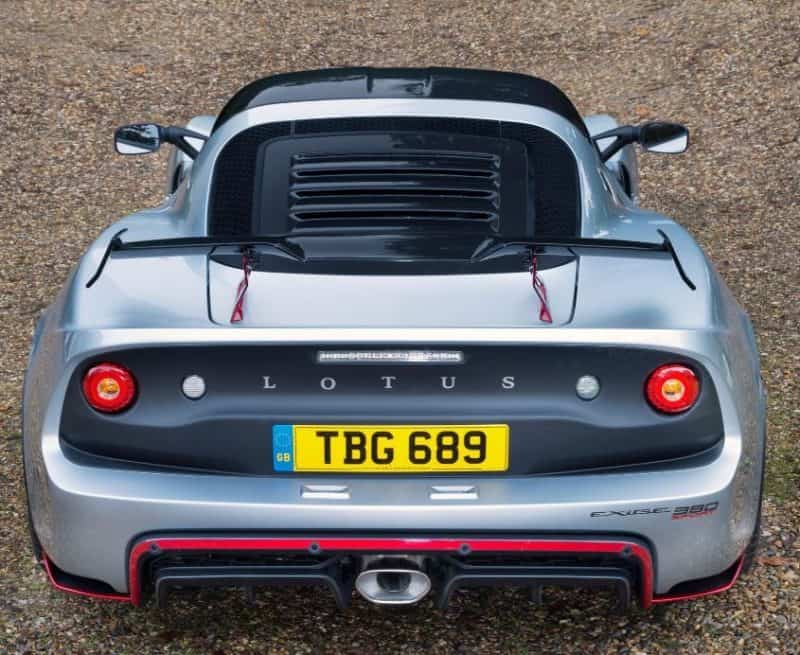No products in the cart.
Dream Cars: LOTUS Exige Sport 380

High powered, highly evolved, and ferociously fast, the Lotus Exige Sport 380 cars are the most aggressive iteration yet for the Exige model line up.
Taking the fight straight to six-figure supercars, this new, top-of-the-range model carries over the lessons learned in the development of the acclaimed Exige Sport 350, launched last year, but with significant revisions lowering weight, boosting power and enhancing aerodynamics.
Rather than relying excessively on electronics, or allow sterile interfaces to dull the experience, the extreme Exige Sport 380 offers a pure, undiluted drive that has to be experienced to be fully appreciated. Unrivaled in its class: these cars are faster, sharper, and more direct than its adversaries, the Exige Sport 380 is definitely not for the timid. With a dry weight of just 1,066 kg with lightweight options, and boasting a potent power-to-weight ratio of 352 hp per tonne, the new, pure-bred Lotus has been conceived to outperform and out maneuver so-called supercars. The new Exige is blisteringly fast off the line, dispatching 0-60mph in 3.5 seconds before reaching a top speed of 178 mph.
From the intricately engineered exposed-gear-change linkage, to the swathes of carbon-fibre components and Michelin Pilot Sport Cup 2 tyres as standard, every inch of the Exige has been carefully cultivated. Firmly defined as a Lotus for the enthusiast, the car can be seen as an expression of intense engineering – challenging accomplished drivers to extract the car’s true potential.
Jean-Marc Gales, CEO of Group Lotus plc, commented: “We’ve saved something special for our last new car of 2016. We have built upon the foundations of the excellent Exige Sport 350 and developed a perfectly proportioned, intuitive and attainable supercar for real roads. The cut in weight is nothing short of drastic and, combined with the hike in power and its enhanced agility, we’ve created something exceptional – far greater than the sum of its parts. The Exige Sport 380 is so good, that it is no longer the best in class, it’s now in a class of its own.”
Unashamedly analog and unfiltered
Lotus’ approach to developing the perfect sports car has allowed the Exige Sport 380 to lay claim to the title of the best sports car under £100,000. A true supercar car for the road, the Exige focuses on the three key attributes that have made the company a firm favorite with driving enthusiasts: reduced weight, higher performance and honed aerodynamics.
Raised on the roads around Hethel, and exercised on the company’s famous test track, the new car can trace its lineage back to the very first Exige, launched in 2000. Now the headline car of the range, sitting above the Sport 350 model, it is instilled with Lotus’ DNA and packed with a potent 375 hp engine into Lotus’ acclaimed two-seater.
Weight less
While employing some of the high-performance components premiered on the Exige Sport 350, Lotus returned to the Lightweight Laboratory in order to cut kilos from the kerb weight. Infused with carbon fibre from front to back, the Exige Sport 380 features handmade, high-gloss visible weave components as standard to deliver a weight saving when compared to the Exige Sport 350. This includes the front splitter, revised front access panel, new rear wing and rear diffuser surround, which together save 2.7 kg. A lightweight, transparent polycarbonate rear window saves 0.9 kg over the glass equivalent in the Exige Sport 350. In addition, the carbon race seats (-6 kg), lithium- ion battery (-10.3 kg), ultra-lightweight forged wheels and grooved two-piece brake discs (-10 kg) combine to cut a massive 26.3 kg. A new design of rear transom panel now has two rear light clusters, rather than the four on the Exige Sport 350, with reversing and fog lights now mounted inboard, cutting weight by a further 0.3 kg.
In line with its illustrious lineage, the Exige Sport 380 employs Lotus’ lightweight extruded and bonded aluminium structure, as the company continues to lead in the field of advanced automotive construction techniques. Lotus is working continuously to engineer out the excess mass from its cars, and the company’s chassis technology remains the benchmark.
Power play
The company’s powertrain division has left its mark on the car, with the uprated 3.5-litre supercharged V6 engine generating 375 hp at 6,700 rpm and 410 Nm (302 lbft) of torque at 5,000 rpm. Refined from extensive testing and development, it’s a design that’s proved its mettle by powering some of Lotus’ latest supercars, including the track-focused 3-Eleven and the recently revealed Evora Sport 410.
The power boost comes from a revised supercharger pulley, which increases charge pressure, an uprated fuel pump, a recalibrated ECU and the introduction of a revised exhaust system – as used in the Evora 400 and Evora Sport 410. Allowing owners to enjoy the new Exige for longer between fuel stops, it also comes with an enlarged, 48-litre petrol tank.
Providing faster, cleaner changes, the Exige Sport 380’s six-speed manual gearbox uses Lotus’ acclaimed open-gate design. Eliminating lateral movement, by precisely aligning components, it features lightweight machined and cast aluminium parts. Aesthetically appealing, the open transmission mechanism also helps contribute to the car’s reduced weight. The manual gearbox has been further enhanced through the introduction of a new oil cooler, ensuring the gears operate at the optimal temperature no matter how hard they are performing.
The Lotus Exige Sport 380 is also available with an optional six-speed automatic gearbox, where drivers can select gears sequentially via the forged aluminum paddles located behind the steering wheel, or rely on the gearbox’s fully automatic mode. The automatic gearbox option will be available from Spring 2017.
The Lotus Exige Sport 380 features Lotus’ Dynamic Performance Management (DPM) which provides enhanced ‘Sport’ and ‘Race’ settings. Proportionally increasing throttle response, lowering traction slip thresholds and removing understeer recognition, it provides the driver with a finer level of control before the system intervenes. DPM also utilizes an engine exhaust bypass valve at mid-to-high engine speeds, further reducing back pressure to boost throttle response and engine performance in both ‘Sport’ and ‘Race’ settings.
As befitting such a stand-out car, the Exige Sport 380 is sprayed and hand finished in one of ten individual colors. Providing some drama and drawing the eye to the beautiful composite carbon components, an optional exterior accent pack is also available in one of five key colors to deliver some finer detailing to the car’s undeniable presence.
The car’s curb appeal is enhanced by revisions to the Exige’s design front and back. Distinctive blackened headlamp surrounds provide a more aggressive demeanor, whilst to visually accentuate the width of rear of the car, a new rear transom features two lamp clusters rather than four.
The hand finished detailing continues inside, with the carbon fiber sports seats trimmed with either Alcantara®, leather or tartan, with all featuring contrast stitching. Inside and out, these dream cars are nothing short of astounding from its speed to its design. Who wants to drive?
Inside and out, this dream car, LOTUS Exige Sport 380 is nothing short of astounding from its speed on the track to its roadster design. Who wants to drive?















Leave a Reply